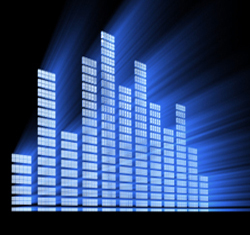
Next use equalization to help with some of the room’s more troublesome features. If the room is exceptionally bright you can beef up the low end to help offset it, or roll-off some of the highs.
Or if the room tends to be boomy, you can tone-down the low end to reduce the resonance. Another way EQ is quite effective is in controlling troublesome feedback tones.
Feedback is that terrible squeal or scream sound systems get when the audio from the loudspeaker gets picked-up by one of the stage microphones, re-amplified and pumped out the speaker, only to be picked-up again by the microphone, and re-amplified, and so on.
Most often, this happens when the system is playing loud, which makes sense, because for softer sounds, the signal either isn’t big enough to make it to the microphone, or if it does, it is too small to build-up.
The problem is one of an out-of-control, closed-loop, positive-feedback system building up until something breaks, or the audience leaves. Use your equalizer to cut those frequencies that want to howl; you not only stop the squeal, but you allow the system to play louder. The technical phrase for this is maximizing system gain before feedback.
It’s important to understand at the beginning that you cannot fix room related sound problems with equalization, but you can move the trouble spots around. You can rearrange things sonically, which helps tame excesses. You win by making it sound better. Equalization helps.
Equalizers are useful in augmenting your instrument or voice. With practice you will learn to use your equalizer to enhance your sound for your best personal expression: deepen the lows, fill the middle, or exaggerate the highs … whatever you want.
Just as an equalizer can improve the sound of a poor loudspeaker, it can improve the sound of a marginal microphone, or enhance any musical instrument. Equalizers give you that something extra, that edge. (We all know where “radio voices” really come from.)
Seeing Sound
To make loudspeaker and sound system measurements easy, you need a real-time analyzer (RTA). An RTA allows you to see the power response, not only for the loudspeaker, but even more importantly, for the whole system.
Stand-alone RTAs use an LED or LCD matrix to display the response. A built-in pink noise generator (a special kind of shaped noise containing all audible frequencies, optimized for measuring sound systems) is used as the test signal. A measuring microphone is included for sampling the response. The display is arranged to show amplitude verses frequency.
Depending upon cost, the number of frequency columns varies from 10 on 1-octave centers, up to 31 on 1/3-octave centers (agreeing with graphic equalizers). Amplitude range and precision varies with price.
With the cost of laptop computers tumbling, the latest form of RTA involves an accessory box and software that works with your computer. These are particularly nice, and loaded with special memory, calculations and multipurpose functions like also being an elaborate SPL meter. Highly recommended if the budget allows.
Also see Exposing Mythology About Equalizers & Equalization by Dennis Bohn.
Dennis Bohn is a principal partner and vice president of research & development at Rane Corporation. He holds BSEE and MSEE degrees from the University of California at Berkeley. Prior to Rane, he worked as engineering manager for Phase Linear Corporation and as audio application engineer at National Semiconductor Corporation. Bohn is a Fellow of the AES, holds two U.S. patents, is listed in Who’s Who In America and authored the entry on “Equalizers” for the McGraw-Hill Encyclopedia of Science & Technology, 7th edition.
